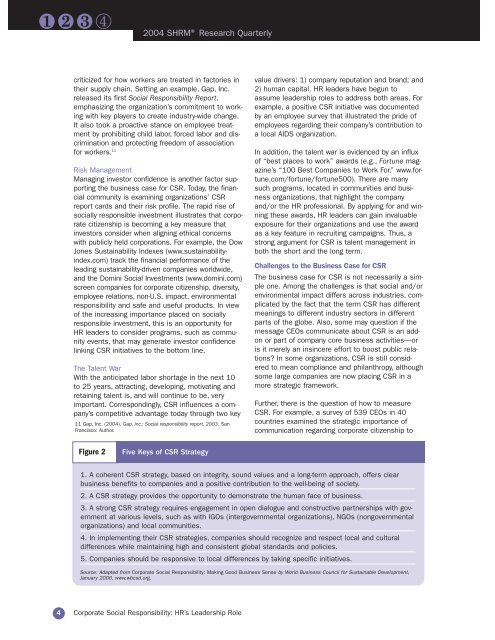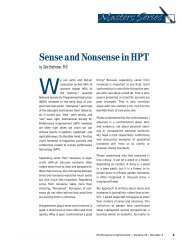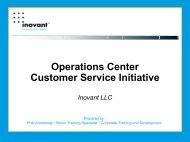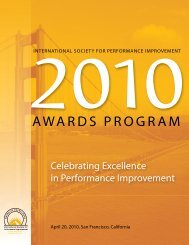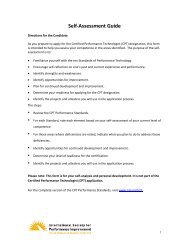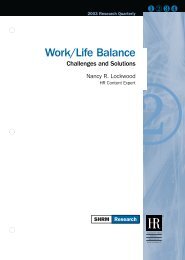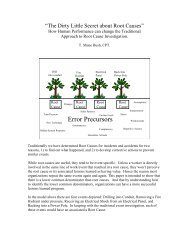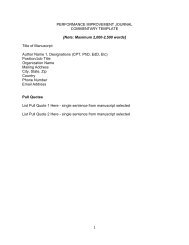Corporate Social Responsibility: HR's Leadership Role
Corporate Social Responsibility: HR's Leadership Role
Corporate Social Responsibility: HR's Leadership Role
You also want an ePaper? Increase the reach of your titles
YUMPU automatically turns print PDFs into web optimized ePapers that Google loves.
2004 SHRM® Research Quarterly<br />
criticized for how workers are treated in factories in<br />
their supply chain. Setting an example, Gap, Inc.<br />
released its first <strong>Social</strong> <strong>Responsibility</strong> Report,<br />
emphasizing the organization’s commitment to working<br />
with key players to create industry-wide change.<br />
It also took a proactive stance on employee treatment<br />
by prohibiting child labor, forced labor and discrimination<br />
and protecting freedom of association<br />
for workers. 11<br />
Risk Management<br />
Managing investor confidence is another factor supporting<br />
the business case for CSR. Today, the financial<br />
community is examining organizations’ CSR<br />
report cards and their risk profile. The rapid rise of<br />
socially responsible investment illustrates that corporate<br />
citizenship is becoming a key measure that<br />
investors consider when aligning ethical concerns<br />
with publicly held corporations. For example, the Dow<br />
Jones Sustainability Indexes (www.sustainabilityindex.com)<br />
track the financial performance of the<br />
leading sustainability-driven companies worldwide,<br />
and the Domini <strong>Social</strong> Investments (www.domini.com)<br />
screen companies for corporate citizenship, diversity,<br />
employee relations, non-U.S. impact, environmental<br />
responsibility and safe and useful products. In view<br />
of the increasing importance placed on socially<br />
responsible investment, this is an opportunity for<br />
HR leaders to consider programs, such as community<br />
events, that may generate investor confidence<br />
linking CSR initiatives to the bottom line.<br />
The Talent War<br />
With the anticipated labor shortage in the next 10<br />
to 25 years, attracting, developing, motivating and<br />
retaining talent is, and will continue to be, very<br />
important. Correspondingly, CSR influences a company’s<br />
competitive advantage today through two key<br />
11 Gap, Inc. (2004). Gap, Inc.: <strong>Social</strong> responsibility report, 2003. San<br />
Francisco: Author.<br />
value drivers: 1) company reputation and brand; and<br />
2) human capital. HR leaders have begun to<br />
assume leadership roles to address both areas. For<br />
example, a positive CSR initiative was documented<br />
by an employee survey that illustrated the pride of<br />
employees regarding their company’s contribution to<br />
a local AIDS organization.<br />
In addition, the talent war is evidenced by an influx<br />
of “best places to work” awards (e.g., Fortune magazine’s<br />
“100 Best Companies to Work For,” www.fortune.com/fortune/fortune500).<br />
There are many<br />
such programs, located in communities and business<br />
organizations, that highlight the company<br />
and/or the HR professional. By applying for and winning<br />
these awards, HR leaders can gain invaluable<br />
exposure for their organizations and use the award<br />
as a key feature in recruiting campaigns. Thus, a<br />
strong argument for CSR is talent management in<br />
both the short and the long term.<br />
Challenges to the Business Case for CSR<br />
The business case for CSR is not necessarily a simple<br />
one. Among the challenges is that social and/or<br />
environmental impact differs across industries, complicated<br />
by the fact that the term CSR has different<br />
meanings to different industry sectors in different<br />
parts of the globe. Also, some may question if the<br />
message CEOs communicate about CSR is an addon<br />
or part of company core business activities—or<br />
is it merely an insincere effort to boost public relations?<br />
In some organizations, CSR is still considered<br />
to mean compliance and philanthropy, although<br />
some large companies are now placing CSR in a<br />
more strategic framework.<br />
Further, there is the question of how to measure<br />
CSR. For example, a survey of 539 CEOs in 40<br />
countries examined the strategic importance of<br />
communication regarding corporate citizenship to<br />
Figure 2<br />
Five Keys of CSR Strategy<br />
1. A coherent CSR strategy, based on integrity, sound values and a long-term approach, offers clear<br />
business benefits to companies and a positive contribution to the well-being of society.<br />
2. A CSR strategy provides the opportunity to demonstrate the human face of business.<br />
3. A strong CSR strategy requires engagement in open dialogue and constructive partnerships with government<br />
at various levels, such as with IGOs (intergovernmental organizations), NGOs (nongovernmental<br />
organizations) and local communities.<br />
4. In implementing their CSR strategies, companies should recognize and respect local and cultural<br />
differences while maintaining high and consistent global standards and policies.<br />
5. Companies should be responsive to local differences by taking specific initiatives.<br />
Source: Adapted from <strong>Corporate</strong> <strong>Social</strong> <strong>Responsibility</strong>: Making Good Business Sense by World Business Council for Sustainable Development,<br />
January 2000, www.wbcsd.org.<br />
4 <strong>Corporate</strong> <strong>Social</strong> <strong>Responsibility</strong>: HR’s <strong>Leadership</strong> <strong>Role</strong>


